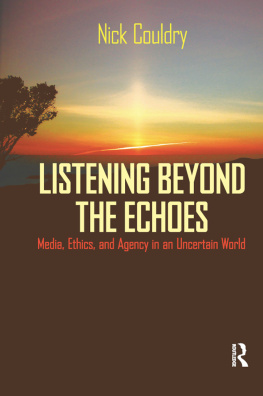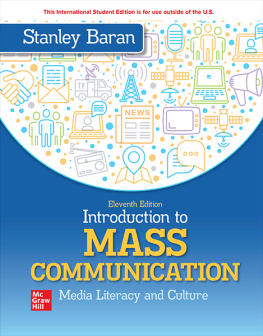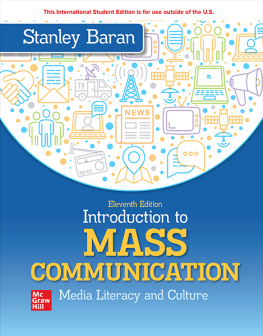When I was seven or eight I came across Antoine de Saint-Exuprys The Little Prince . The novel begins, like this book, with the memory of an illustration. The narrator, a pilot stranded in the Sahara Desert after a crash landing, remembers an illustration he had seen as a child of a boa constrictor eating an elephant. Saint-Exuprys pilot goes on to detail his encounter with a finely dressed little boy who, having appeared in the middle of the desert one morning, unexpectedly demands a drawing. A drawing of a sheep. After several rejected attempts, the pilot gives the Little Prince the drawing of a perforated box.
This classic story illustrates my argument. What is mediation? Mediation does not refer to the object, the apparatus, the technology. These are mere caskets, containers, vessels. There is something incommunicable that inhabits matter. And yet, matter is not mute. The medium may well be the message in the case of communication media. In the case of transmission media, however, the medium is the energy. Raw matter is inhabited by a vitality (an energy) that can be transmitted from body to body, from body to land, and back. Mediation is not only dependent on man-made objects or media things, and it is certainly not limited to language and technological media communication. Mediation implies a condition of matter-transmission. My point is that matter-transmission is prior to any manmade system of technological mediation. You do not need a photograph. You do not need a drawing. You do not need a video recording or sound recording to transmit, in a mediated way, the Little Princes sheep. All you need, in this case, is imagination, and the material means of expressing it, which can come in the form of a graphic illustration, but also in the form of a sheep-looking outcrop in the desert wasteland or a fluffy cloud that resembles fleece, or a passing wind that bleats. Mediation can be mobilized in the graphic illustration, as well as the rock, or the cloud, the wind. The gap that requires mediation, the space that is filled with transmission, is not necessary between one person and another. Mediation is not just intersubjective, from pilot to Little Prince, or from machine to human. Mediation, when considered a strictly material transmission of energy or essentialized matter, is also a go-between that tethers body and landscape.
Behind Saint-Exuprys image of the perforated box is an imagined sheep. The point is simple. The illustration can exist without its object. Without a drawing, a photo, a motion picture. The Little Prince s illustration belongs to the realm of the imagination. You cannot communicate that imagination, but you can transmit it. This suggests that there is a fundamental difference between communication media (reliant upon media objects) and transmission media, which relies on an energy that inhabits matter. In the case of the Little Prince , imagination is the energy that feeds the graphic image of the sheep. Saint-Exuprys illustrations have been reproduced, imitated, mimicked, remediated. A history of media objects begins with the first publication of this bestseller in 1943. The imagination, however, escapes that history. Memory and the material imagination remain always present in those who have read the book and who cherish it, remember it, recall it, or deploy it to make sense of their everyday lives.
The problem with all the drawings the Little Prince discards before opting for the perforated box is that they are too realistic, too representational. In every one of them the narrator unsuccessfully tries to represent sheep. The point of a living image, in this classic childrens story, is not to represent sheep in general, nor indeed to represent the sheep, that is, the particular specimen the Little Prince is thinking of, but to activate the means to imagine. That is why the perforated box is the perfect image, at least in the eyes of the Little Prince. It functions as an opening, a gateway for the mediating force of pure imagination.
My choice to include drawings here, as opposed to photographic material, is quite deliberate.
This book is about images (optical, sonic, kinesthetic, tactile) which are transmitted by the rocky walls of caves. My focus is the memory, the imagination, and the sensation transmitted via the medium of image-filled landscape. Since I cannot think of many books devoted to this particular type of mediation, it behooves us to pay more attention to the landesque immersion; to the physical, somatic, sensorial, transmissions of life experienced in immersive landscape. To the extent that the medium in question is not a technological one, the medium of the cave is not dependent on the makeability of media in the form of artificial artifacts, objects, things, or systems. The drawings I include in this book do not provide the means for objective analysis, but rather help me consider the way I remember or imagine the subterranean landscape I have experienced and felt over the course of my investigations.
Matter Transmission is about prehistoric conditions of mediation that also happen to be contemporary. By prehistory I do not mean a time before the historical past. Prehistory is the imagination before an image, the memory before a photograph, the sensation before a written thought. Histories start with objects, with reification. Transmission, however, does not start with history, nor its objects. Cultural transmission, as mediated by collective imaginaries and memories, are always prehistoric, whether today or twenty thousand years ago. Since that which has the power to mediate is not necessarily media technology and its objects, then media technology can only be the present historical condition by means of which communication and transmission are made possible. Much more substantial than that, I argue, is the mediating power of essentialized earthly materiality. Landscape transmits. It speaks, projects, moves, smells, and tastes; it is full of image and thought, laden with affect it channels itself. If you do not accept that raw nature transmits energy, then drop this book. If you do not agree that rock, tree, cloud, and water are transmission media, you should read no further.
The core argument has been exposed. The dominant understanding is that the power to mediate is a function reserved for communication and transmission technologies, to the extent that the content of human group communication is meaning, information, recorded image and sound, hard graphics, which are physically transmitted via guided media (electric cables or fiber optics) or unguided media (radio, microwave, satellite). Landscapes and mediascape are not the same, because both communication and transmission are, as is commonly perceived, technological. But technology has a prehistory, just like the image is preceded by the imagination. The techno-cultural panorama seriously jeopardizes a more ecological sense of material and raw mediation. My thesis can be exposed further: when technological mediation is no longer accepted as the sole agency for mediated communication and transmission, what comes to take its place is nature-in-the-raw. Landscape and its elements: these are also media. Caves, for instance, are media. They can transmit physical memories and imaginaries that are always present at the physical and geophysical levels.
Matter is media








